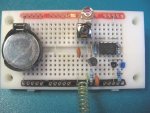Eclectic: These are mostly just plain crystals- not the packaged crystal oscillator (XO)
HMR: Thanks for that DigiKey link- lots of prospects, but odd ball freqs. abound still!
Prior to freq. synthesis,many radio hams (including myself) were heavy raw crystal users, especially on VHF ~144-148 MHz, and even back in the mid 1960s I used to import from the likes of Jan Crystals, Fort Myers Florida - they're still going! You could specify any freq., & package, cut etc. Things peaked during the mid 1970s CB craze- cheap sets abounded that suited conversions to other freqs. All manner of VXO (Variable Crystal Oscillator) tweaks & circuitry evolved.
I for one really need to make a study of current packaged XOs, freqs. & overtones. Such classics as 3.579545 MHz NTSC TV colour burst are well known (& much used as "engines" elsewhere), but the rationale for that 28.322 MHz offering package escapes me. x3, x5, x7, x9 harmonics don't seem to fall anywhere useful. 3 x 28.322 MHZ = 84.966MHz & thus off the bottom of the FM band. Steve - the producer of that Morse beacon- mentions a 10 yo. 486DX-100 MHz motherboard was the source for his project in fact.
FWIW however, 28.322 MHz is right in the middle of the global 10m ham band global beacon network, & that freq. should hence be avoided for any non ham PICAXE driven transmitters. When propagation conditions suit, 40mW can span oceans with a decent antenna!



